
Marian McCredie Renames West House in Memory of James McCredie
The American School of Classical Studies at Athens is pleased to announce a munificent gift from Marian M. McCredie in support of the renovated Student Center. Mrs. McCredie has renamed West House in memory of her late husband, James R. McCredie, whose close association with the School spanned six decades. McCredie House will be a lasting tribute to his extraordinary impact on the School.
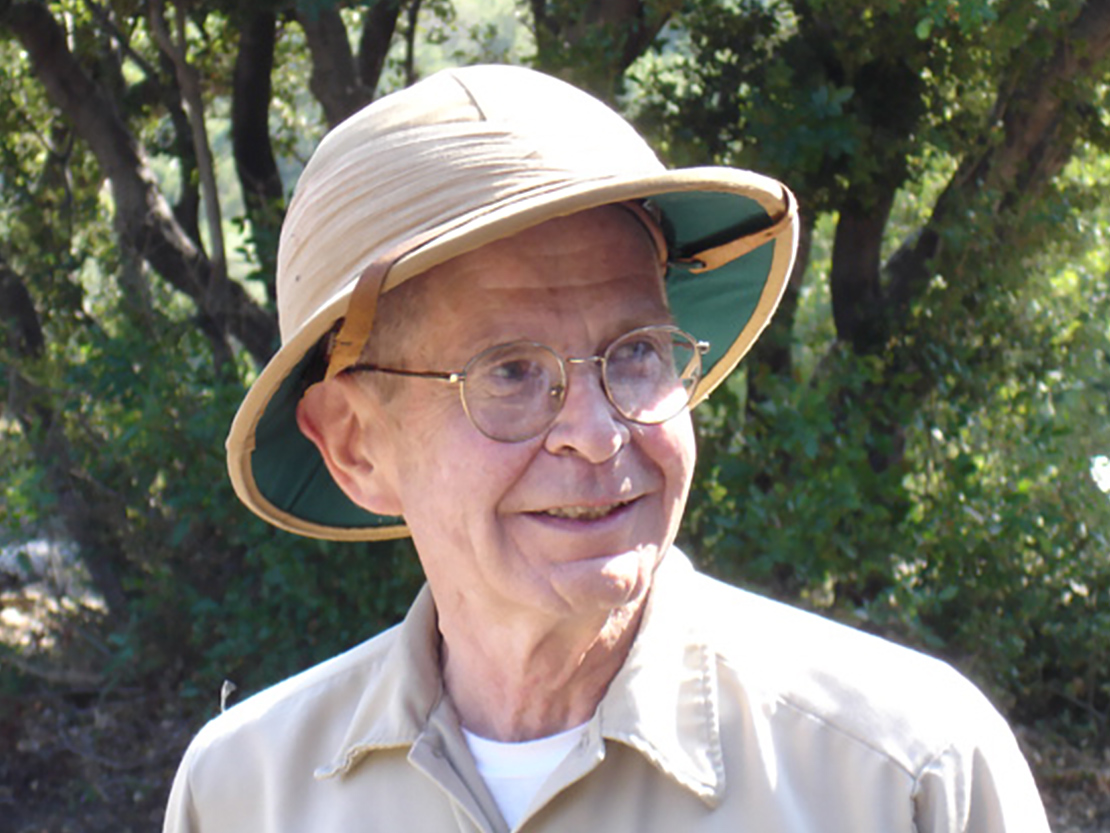
| James McCredie wearing his iconic pith helmet (photo courtesy of Patrick Cardon) |
Mrs. McCredie expressed great joy in her gift: “James dedicated himself to the School for so much of his life. I think back especially to the time we spent on Souidias Street when he served as Director. Those were happy years for both of us. He loved his work; we loved Athens and raising a young family right there at the School. And we both thrived on our interactions with the students—people like Carol Mattusch, Robert Pounder, and Richard Mason—whether out on a School trip to the Peloponnese, mingling at a cocktail party in the School gardens, or visiting in Loring Hall. We saw part of our role as providing a sense of community and home for the students. That is why I am delighted to have James’s name associated with a place that will provide students with that sense of home and community for years to come.”

| McCredie House (boxed area) on the American School’s campus in Athens |
Located at the west end of the courtyard garden embraced by Loring Hall and its Annex, West House was originally designed to accommodate one visiting professor with a family. Remodelled as McCredie House, each floor will contain a one-bedroom apartment for a senior scholar, but with the flexibility to combine two or even three apartments to accommodate those with larger families.

| A plaque commemorating James McCredie hangs in the Blegen Library of the American School |
William T. (Rob) Loomis, President of the School’s Trustees, said: “In an institution that has had many giants over its 139-year history, Jim McCredie was arguably the leading giant of the American School in the late 20th and early 21st centuries. In addition to serving as a longtime member of the Managing Committee (1961–2018) and trustee of the School (1980–2018), Jim holds the distinction of being the only person to have occupied all three of the School’s chief offices: Director of the School (1969–1977), Chair of the Managing Committee (1980–1990), and President of the Trustees (2001–2010). During much of that time, Jim was also Director of New York University’s Institute of Fine Arts (1983–2002) and Director of the Samothrace Excavations (1966–2012).”

| At a reception in Athens in 1969, James McCredie (far right), Director of the American School, was joined by Ward Canaday, Chairman Emeritus of the Trustees (third from left); Spyridon Marinatos, Director General of Antiquities and Conservation for the Greek Ministry of Culture (fifth from right); and Richard Howland, Chairman of the School’s Managing Committee (second from right) (photo courtesy of ASCSA Archives) |
“Although the foregoing list might suggest that Jim was ‘only’ an academic administrator, he also was a productive scholar, publishing Fortified Military Camps in Attica (1966), a work that overturned long-held ideas about Hellenistic chronology, and The Rotunda of Arsinoe at Samothrace (1992), a painstaking and ingenious reconstruction of the largest enclosed free space in a round building in the Greek world. Moreover, while serving as Director of the School, Jim shouldered half of the teaching burden, splitting the Fall Trips and Winter Athens and Attica program with Professors Eugene Vanderpool and Willy Eliot—something that no Director since Jim has ever attempted!”

| Members of the Board of Trustees in 2010: (from left) Charles Williams, Malcolm Wiener, Elizabeth Gebhard, Andrew Bridges, Judith Thomson, Joan Bingham, Robert Maguire, Mary Sturgeon, Henry Davis, Mary Lefkowitz, William Loomis, James McCredie, Paul Friedland, Jane Buikstra, and Jonathan Cohen (photo courtesy of ASCSA Archives) |
Loomis continued: “As Director, Managing Committee Chair, and Board President, Jim combined a keen awareness of the School’s history and mission with superb judgment in resolving a number of delicate budgetary and personnel issues. Because he was an academic superstar himself, he never was overly impressed with other academic superstars, and instead reserved his special praise for good judgment: his highest compliment was ‘he/she usually gets it right!’ He did not feel threatened by disagreement, and he never tried to shut down discussion. In the end, however, he was very confident of his own judgment and did not hesitate to make decisions. His confidence in his own abilities and judgment meant that he did not feel any need to gratify his own ego: the focus was never on what would make Jim look good but rather on what was best for the School. Finally, he was a great financial benefactor of the School. The School needs more people like Jim!”
"On behalf of the Trustees, I would like to express our profound gratitude to Mimsy McCredie, not only for this spectacular gift, but also for her eight years as a charming and effective hostess for the American School."
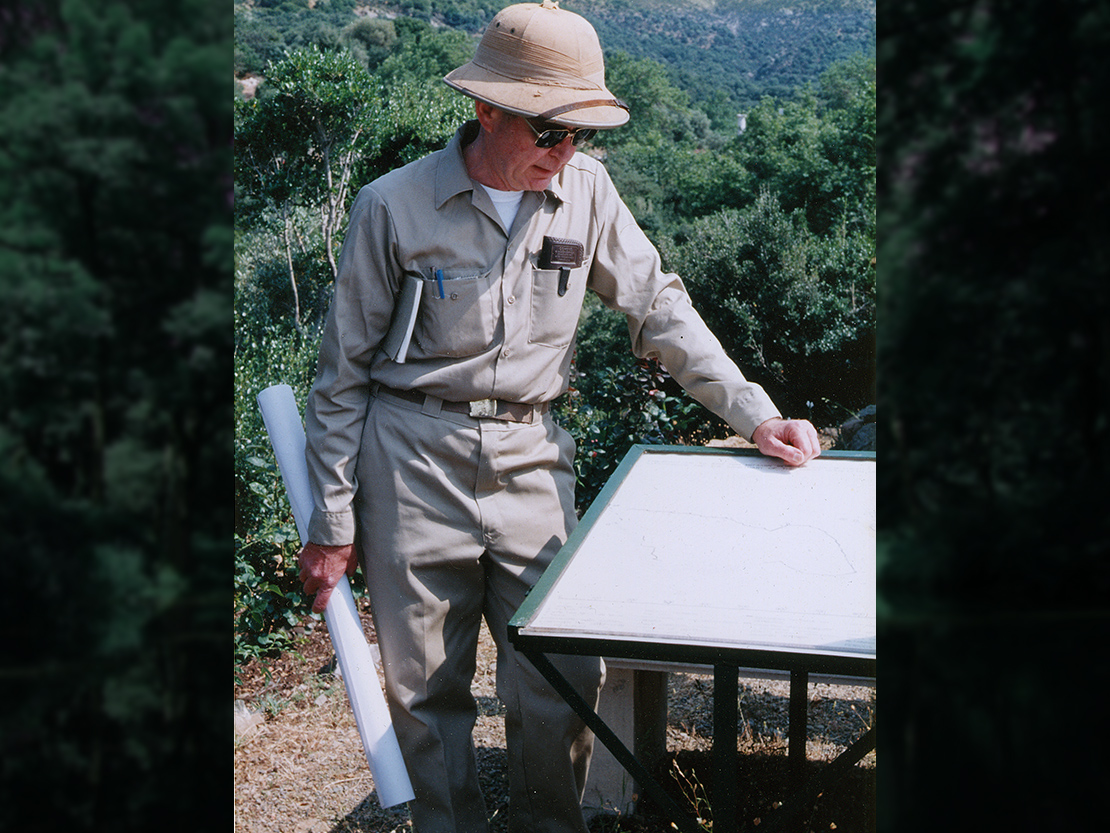
| James McCredie explains a drawing during one of his renowned Samothrace tours, 1993 (photo courtesy of Catherine deG. Vanderpool) |
Charles K. Williams II, Director Emeritus of the School’s Corinth Excavations, recalled: “Respect and reliable friendship are two outstanding characteristics that James embodied and what I admired most about him. If more people were like him, we would have a much pleasanter world.”

| Marian and James McCredie prepare to greet guests at their Samothrace villa in 1987 (photo courtesy of Robert Pounder) |
Gennadius Library Overseer Robert Pounder, who served as Secretary of the School (1970–1971) and Assistant to the Director (1974–1975) under McCredie, said that McCredie immediately infused a different spirit into the air as Director of the School: “Jim came with his family, which included two young children, Miles and Meredeth; a governess, Mrs. Bowser; and of course, his wife, Marian, known to all as ‘Mimsy.’ Young children were a true novelty at the American School, and a sandbox and jungle gym and see-saw appeared for the first time at the bottom of the garden. These symbols of childhood play became metaphors for a transformation of the way the School was run.”

| The McCredies (from left: Meredeth, Mimsy, Miles, and James) in the American School gardens, ca. 1971 (photo courtesy of the McCredie family) |
Pounder added: “The McCredies opened their house to all, for teas and dinners and post-lecture receptions. Greek colleagues were always included, as were members of the other foreign schools. Young and old sat down to dinner together: Virginia Grace with a first-year student, Alison Frantz with a member of the Archaeological Service, Oscar Broneer with an Italian epigrapher. The food set a new standard too, thanks to Jim’s culinary skills; he taught the cook how to prepare everything from Thanksgiving turkeys to the best chocolate sauce you ever tasted.”

| The McCredies hosting a goat roast at Agia Paraskevi in Samothrace for the local mayor, friends, and colleagues, 1971 (photo courtesy of Ioannis Akamatis) |
In her History of the American School of Classical Studies, 1939–1980, Lucy Shoe Meritt wrote, “James McCredie’s loyal devotion to the purposes and programs of the School directed it to peaks of achievement and international respect, led by his own example. [Chair of the Managing Committee (1975–1980) Mabel] Lang’s tribute read to the Managing Committee when he completed his Directorship should be recorded, at least in part: ‘devoted director, active excavator, polished and principled diplomat, genial host, tireless teacher and proficient professor, master of budgets, understanding counsellor, efficient administrator, serious scholar, creative innovator, effective housekeeper’ to which should be added his light but firm touch and saving sense of humor as part of his sense of proportion no matter how tough the going or bleak the financial scene.”

| James McCredie teaching students in Samothrace, 2006 (photo courtesy of Bonna D. Wescoat) |
Bonna D. Wescoat, Director of the Excavations in the Sanctuary of the Great Gods at Samothrace, noted, “Jim McCredie gave us some of the most splendid buildings of the Hellenistic Age. We can fairly claim that no other archaeologist of the 20th century so profoundly transformed our understanding of an ancient Greek sacred place. Although Jim’s discoveries made him justly famous within the archaeological world, he was especially proud of the many students who trained under his leadership. He encouraged students in all periods in the history of art, archaeology, and conservation to participate in field research, expanding the impact of archaeological research and training across the disciplines. Some three generations of students and scholars learned and worked under his guidance and mentorship. Many of us owe their careers to his support and encouragement.”

| James McCredie presides over ouzo hour at Samothrace, 2005 (photo courtesy of Bonna D. Wescoat) |
In 2012, the School’s Alumni/ae Association presented McCredie with its Aristeia Award. On that occasion, James Wright (Director of the School 2012–2017), said of McCredie’s jovial personality: “Having fun is important to Jim. It has been the way he has been able to move institutions forward and help people along in their pursuits. Behind that demeanor there is a consistent sensitivity to the needs and feelings of others, a knack for seeing to the core of a problem, and consummate good judgment. This is the recipe for his success as a steward of institutions.”
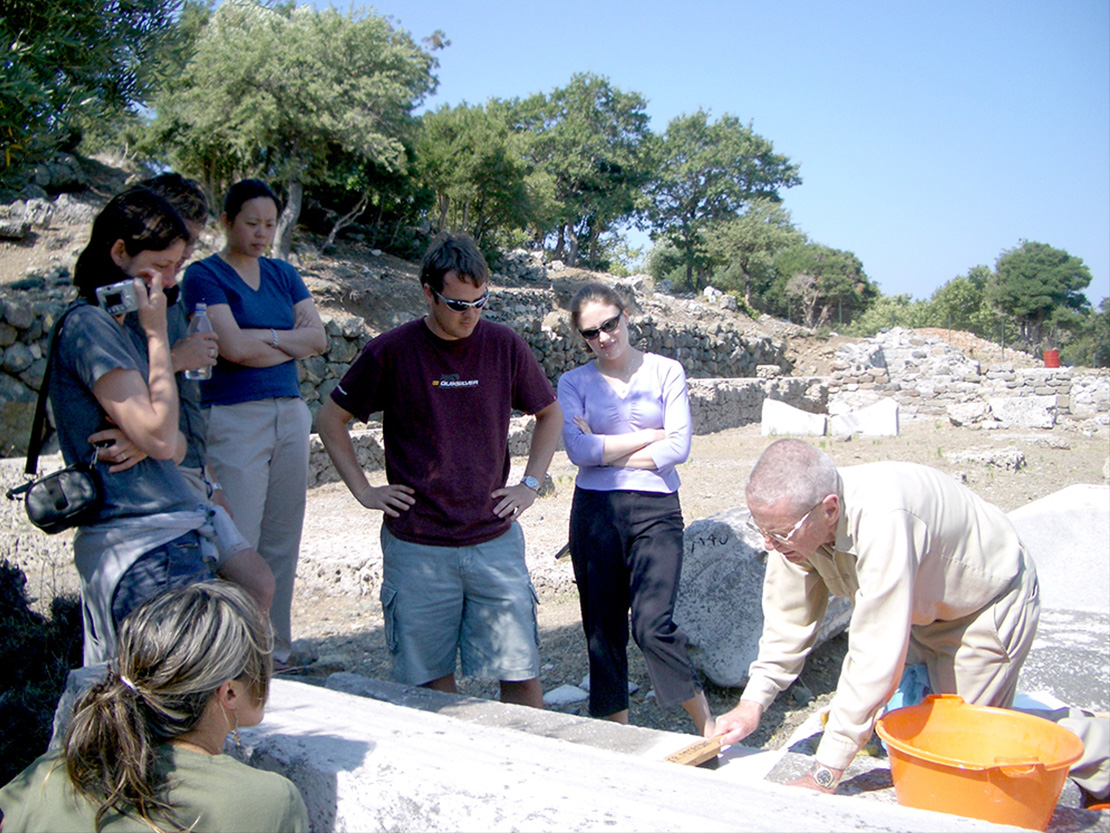
| James McCredie demonstrates how to make a squeeze (photo courtesy of Bonna D. Wescoat) |
Wright continued: “Who among the students and scholars at the School when Jim and Mimsy ruled the roost does not remember a favor bestowed, a sound piece of advice, a careful seating next to just the right member of the Archaeological Service or one of the foreign schools, at a formal dinner in the Director’s residence? Their attention to detail and their gracious follow-through advanced many a career and set an example to follow.”
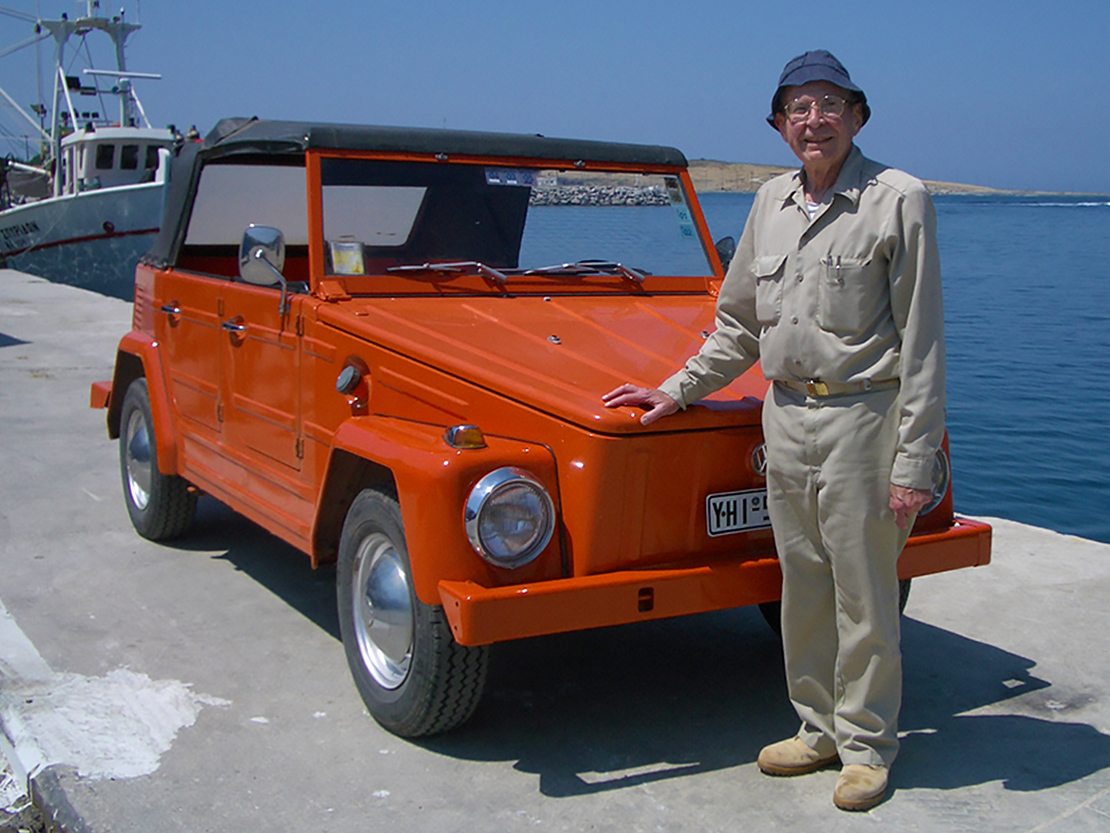
| James McCredie, with his beloved orange Volkswagen Thing, “Sylvester,” waiting to pick up colleagues at the Samothrace port, ca. 2008 (photo courtesy of Bonna D. Wescoat) |
Christopher Pfaff, Director of the School’s Corinth Excavations and former student of Jim’s at the Institute of Fine Arts, reflected, “What I remember most fondly about Jim McCredie was his inimitable laugh, which often followed one of his own humorous, self-deprecating remarks. Jim was more astute than most in distinguishing between real value and hype, and he had a devilish way of poking holes through bad ideas and overinflated reputations. From him I learned the valuable lesson of not thinking too highly of myself or of others. In the modern day where we are all encouraged to believe we are special, Jim provided a countervailing voice reminding us that we might not be quite so special, but that we should just get on with our work and have fun doing it.”
ABOUT JAMES R. McCREDIE
James Robert McCredie was born on New Year’s Eve of 1935 in Chicago, Illinois, to William and Mareta (Black) McCredie. He traveled east to attend Phillips Exeter Academy, where he received a classical diploma. Throughout his life, people knew him as a Harvard man. He graduated summa cum laude with an A.B. in History and Literature (1958) and also received his Ph.D. (1963) from Harvard with his dissertation, “Fortified Military Camps in Attica.”

| James R. McCredie, ca. 1960s (photo by prominent portrait photographer Fabian Bachrach, courtesy of the McCredie family) |
He was one of those fortunate people whose talents, interests, and career aligned. In an interview, McCredie once shared the following interpretation of his path into archaeology: “The Greek historian [at Harvard, Sterling Dow] said, ‘Do something useful,’ so he sent me out to Gordion in Turkey to dig, and I thought that was fun…” And, while his seriousness as a classical archaeologist, as a gifted teacher, and as a generous mentor was never in doubt, fun was always integral to, and perhaps a secret to, his success.

| The McCredies’ wedding in Athens (photo courtesy of the McCredie family) |
On September 4, 1960, McCredie wed Marian Lucille Miles in Athens. The reception was held at the American Embassy in Greece where the bride’s uncle was ambassador at the time.

| The McCredies en route to their wedding reception at the American Embassy (photo courtesy of the McCredie family) |
In 1962, McCredie began an association with the island of Samothrace in the northern Aegean that would last the rest of his life. He joined the small team of archaeologists excavating and researching the Sanctuary of the Great Gods and assumed the role of Director in 1966. The Sanctuary was the center of one of the most famous mystery cults of Greek antiquity, dating to the fourth century B.C. Over the next 50 years of excavation and research, he transformed scholars’ understanding of Hellenistic architecture. His time as a field archaeologist was generously shared with hundreds of students who thrived under his patient direction and mentoring.

| The McCredies in Elgin, Illinois, celebrating Jim’s parents’ 50th wedding anniversary in 1972 (photo courtesy of the McCredie family) |
He was appointed Director of the American School in 1969, just six years after finishing his dissertation. During his eight-year tenure, he set a standard that future Directors would strive to meet. He carefully guided the School through unsettling times under the Junta in Greece, putting it at the epicenter of classical studies in Greece. The School staff was very small at the time, requiring McCredie to take on many roles, including administrator, leader of School trips, lecturer, excavator, and student advisor and mentor. One of the many accomplishments of his directorship was the construction, in collaboration with Gennadeion Director Frank Walton, of the east and west wings of the Gennadius Library, including the installation of the Stathatou Macedonian Room and the Library’s subsequent reopening in 1973.
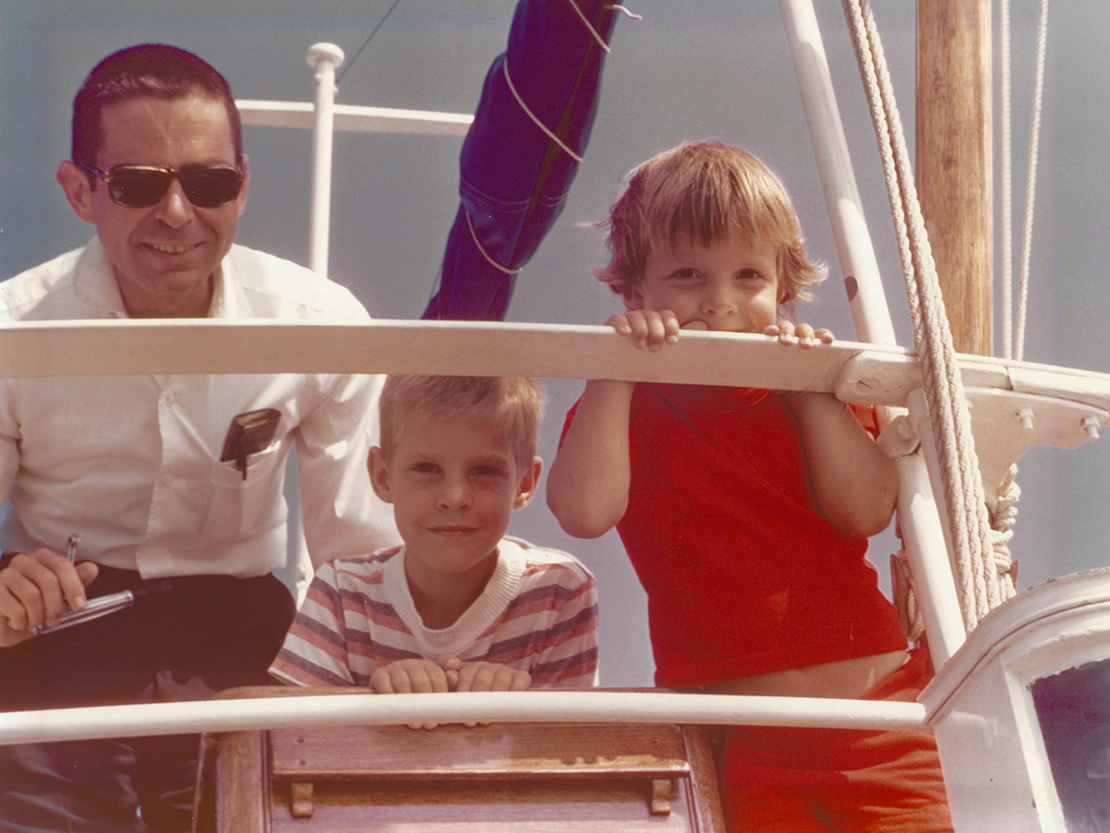
| The McCredies leaving Samothrace, ca. 1973 (photo courtesy of the McCredie family) |
After returning to the United States in 1977, McCredie chaired the School’s Managing Committee from 1980 until 1990 and served as President of the School’s Board of Trustees from 2001 until 2010. During his stewardship as Managing Committee Chair, the School celebrated its centennial and built the Blegen Library’s new wing, greatly expanding book stacks and providing space for the School’s Archives, a new archaeological laboratory, a computer laboratory, and a seminar room.
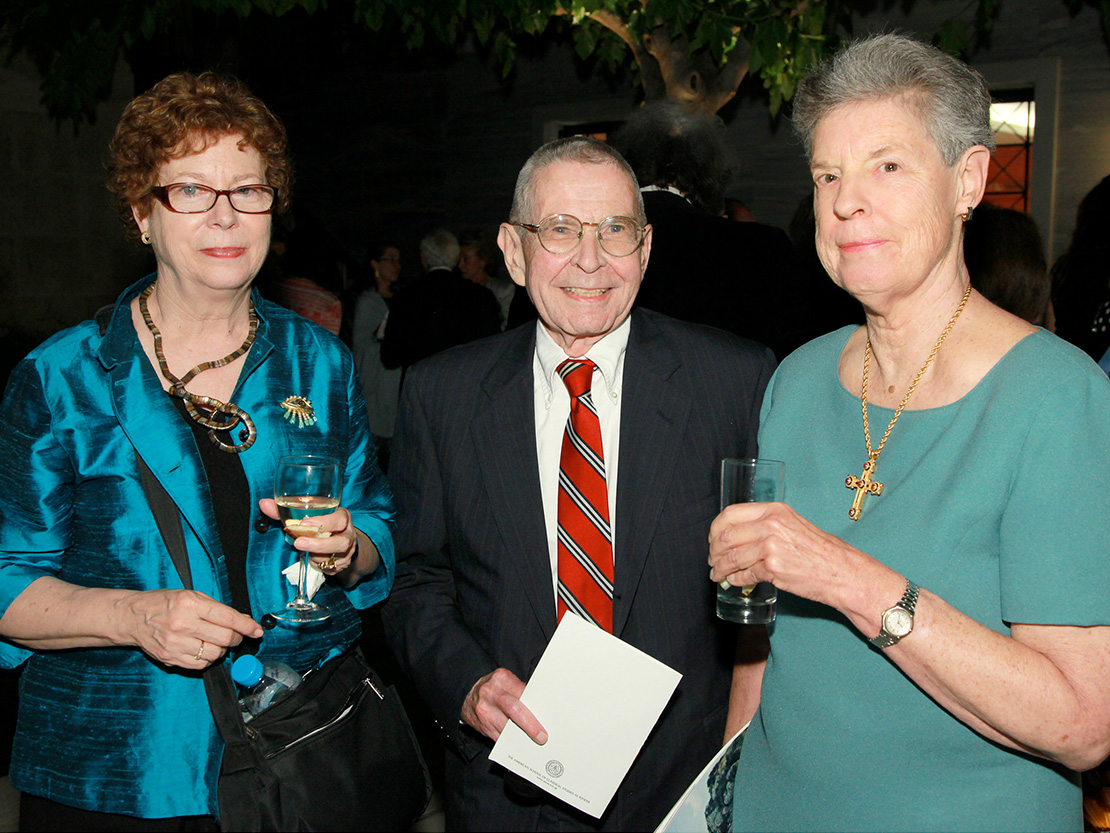
| Managing Committee Chair Mary Sturgeon (left) with James and Marian McCredie in Athens for the School’s 130th anniversary celebration in 2011 (photo by Haris Akriviadis) |
His academic career was primarily with the Institute of Fine Arts in New York. McCredie came to the Institute in 1961 as an instructor, rose to professor in 1978, and served as Director from 1983 through 2002. In 1988, he was named Sherman Fairchild Professor of Fine Arts, becoming emeritus in 2002.

| James McCredie with his grandson Will outside the excavations workshop in Samothrace, July 2008 (photo courtesy of the McCredie family) |
In addition to numerous other awards and distinctions received over his lifetime, McCredie was a member of the American Philosophical Society, a member of the Institute for Advanced Study, an honorary citizen of Samothrace, and the recipient of an honorary degree from the National and Kapodistrian University of Athens. Colleagues and pupils paid tribute to McCredie with a Festschrift, Samothracian Connections: Essays in Honor of James R. McCredie (edited by Olga Palagia and Bonna D. Wescoat). This volume of 18 papers celebrates his outstanding contribution to the excavation and study of the Sanctuary of the Great Gods at Samothrace.

| James McCredie with his grandchildren, Will and Ellie Winter, and a family friend in the Sanctuary of the Great Gods at Samothrace, demonstrating where the Victory of Samothrace may have stood, July 2008 (photo courtesy of the McCredie family) |
Beyond the particulars of his prodigious career in academia and classical archaeology, McCredie will be remembered for his self-effacing personality, his insistence on always giving credit to others, his wry and ready sense of humor, his consummate good judgment, and his patient attention to detail.
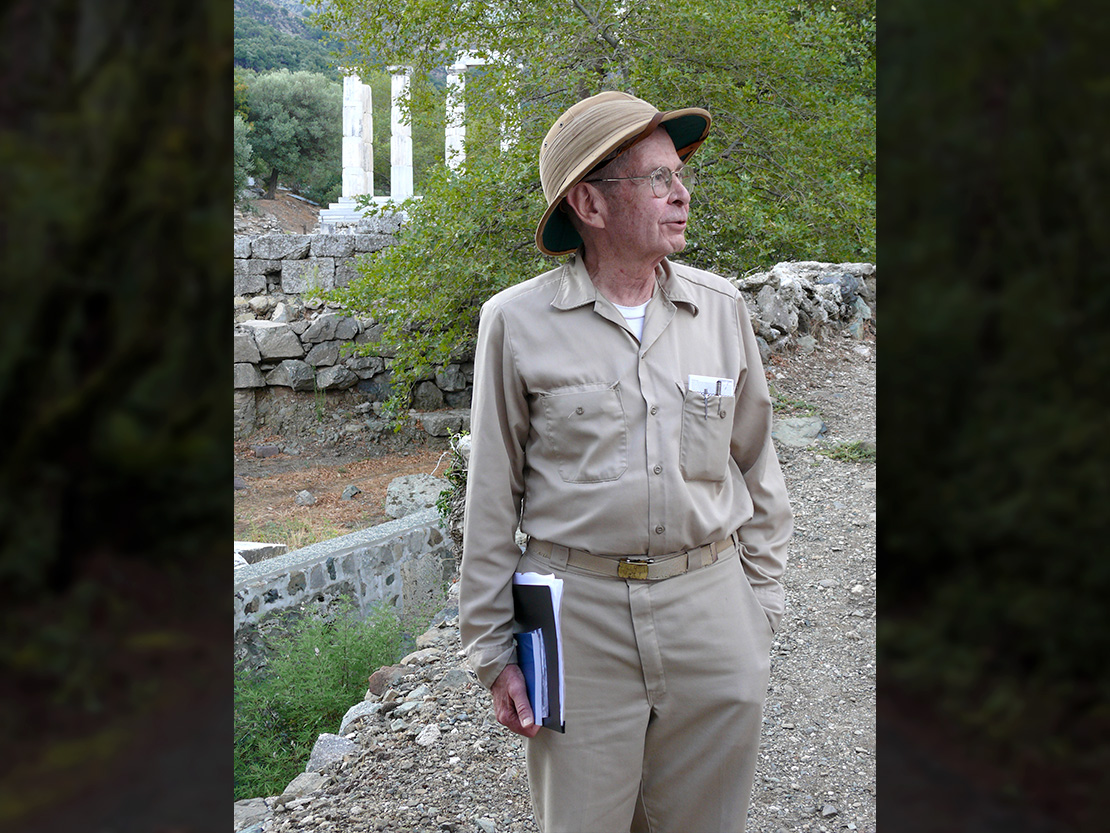
| James McCredie in his familiar excavation attire at Samothrace, 1993 (photo courtesy of Robert McCabe) |
McCredie died on July 15, 2018, at the age of 82 in Plainsboro, NJ. He was survived by his wife of 58 years, Marian Lucille Miles McCredie; son Miles William McCredie; daughter Meredeth McCredie Winter; son-in-law Mark Jay Winter; grandchildren William Vanderhoek Winter and Eleanor Cornelia Winter; and the countless students and colleagues whose lives he influenced.
Source: The McCredie family
ABOUT THE STUDENT CENTER CAMPAIGN
The Student Center Campaign was launched in October 2018 to raise funds for renovating and expanding the three aging buildings that serve as the intellectual and residential heart of the American School: Loring Hall, the Annex, and West House. This transformative project will increase housing capacity, reduce energy consumption, add state-of-the-art features and technology, and bring the buildings up to the latest technical standards—all while preserving the complex’s historical appearance. The Student Center will remain the place where members of the community gather for meals, tea, ouzo hour, holiday celebrations, and lectures—a source of lifelong professional and personal relationships that characterize the collegial and intellectually vibrant atmosphere of the School. This modernized setting will enhance that experience and will meet the needs of the School community well into the future.
SUPPORT THE CAMPAIGN
The goal of the Student Center campaign is $9.4 million, inclusive of a maintenance endowment. Thanks to generous supporters like Marian McCredie, $7.7 million has been raised to date. The new Student Center is expected to open in June 2021.
To learn more about how you can support this historic initiative, please contact Nancy Savaides, Director of Stewardship and Engagement, at nsavaides@ascsa.org or 609-454-6810. Naming opportunities for a variety of spaces in the Student Center are still available. Donors can choose from a wide range of gift levels to name a room or area in honor of themselves, an American School scholar, or a family member, friend, or group. Please click the links below to view the nameable spaces and options that remain:
STUDENT CENTER CONSTRUCTION PHOTO GALLERY
Click this link to view more photographs of the work in progress.
